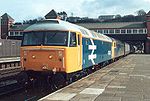The British Rail Class 47 is a class of British railway diesel locomotive. The Class 47 history begins in the early 1960s with the stated aim of the British Transport Commission (BTC) to completely remove steam locomotives from British Rail by a target date of 1968. A total of 512 Class 47s were built between 1962 and 1968 at Crewe Works and the Brush Falcon Works in Loughborough, making them easily the most numerous class of British mainline diesel. They were fitted with the Sulzer 12LDA28 double straight-six unit producing 2,750 bhp (2,050 kW). In the early 1970s, the fleet were renumbered into the 47xxx series to conform with the computerised TOPS systems. This enabled a number of easily recognisable sub-classes to be created, depending on the differing equipment fitted. They have been used on both passenger and freight trains on Britain's railways for over 40 years. By 1986, only five of the original 512 locomotives had been withdrawn from service. In 2007, after more than 40 years of front line passenger and freight operations, around thirty locomotives are still currently operational on the National network. Class 47s have proved very popular with preservationists and private railways, and more than 30 have now entered preservation, with the majority in working order. Also, a total of 33 withdrawn locomotives have been rebuilt with EMD engines and re-classified as Class 57s.
Recently selected: History of rail transport in the Netherlands - SR Merchant Navy Class - Metropolitan Atlanta Rapid Transit Authority
